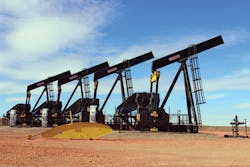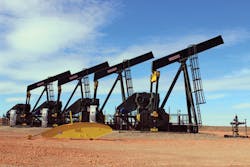Rachael Seeley, Editor
Bakken shale production set another record in August, but weakening crude prices and flaring reduction efforts threatened to temper production growth.
The state produced 1.13 million b/d of oil and 1.3 bcfd of gas during the month, yielding a production growth rate of 2%. The growth rate was 4% in August 2012 and August 2013, said Lynn Helms, director of North Dakota Mineral Resources.
Helms addressed a monthly webinar hosted by the North Dakota Industrial Commission on Oct. 15.
Completions were delayed by at least two operators to comply with the state's first mandatory flaring reduction target. By Oct. 1, producers were required to capture 74% of their natural gas production or face mandatory production curtailments in January.
"The number one impact there was gas capture plans. I've talked to two different operators in the past week, and both of them had postponed anywhere from 20 to 40 completions because they want to arrive at that 74% [target]," Helms said.
Weakening crude prices were also cited. The average price of North Dakota Sweet (NDS) crude was $78.46/bbl in August, down from $86.20/bbl in July, according to pricing information from Flint Hills Resources. On the day of the webinar, the price of NDS fell to $66.25/bbl.
Weakening crude prices contrasted with rising operating costs. In testimony to the state, producers have cited a year-over-year operating cost increase of 36%.
"The average operating cost for a Bakken-Three Forks well is now just under $15,000/month," Helms said. If weak crude prices persist, Helms expects producers will seek to reduce operating costs and may then begin to lay down rigs.
At crude prices below $70/bbl, drilling in Burke, Bowman, and Slope counties is uneconomic. "We've taken a look at the operating costs on a county by county basis, and we have three counties that-right now, at less than $70/bbl-are below break-even," Helms said.
These counties have higher costs than those in the Bakken core due to relatively low initial production rates, high water disposal costs, and a reliance on diesel power generation.
"The main factor is the initial production rate," Helms said. "With Bakken and Three Forks wells, the big payout period is in that first 1-2 years, so that initial production rate is a huge driver [of profitability]."
Tax incentives
Weak crude prices and slowed production growth were expected to reduce tax revenues, placing pressure the state budget. Helms said the state's revenue forecasting group was set to reconvene on Oct. 31 to recalculate budget projections. "I'm quite positive there will be a [budget] revision," Helms said.
A preliminary budget was based on $90/bbl oil.
Producers can look for tax relief if prices fall below a certain threshold. A statewide tax incentive for new horizontal wells becomes effective when the price of benchmark West Texas Intermediate (WTI) crude falls below $52.06/bbl for 5 consecutive months.
If this tax reduction is triggered, Helms said, the oil extraction tax will fall to 2% from 6.5%. New horizontal wells would lock in the lower tax rate for the first 2 years of production, regardless of when normal tax rates resume.
The tax incentive expires when the price of WTI crude remains above $52.06/bbl for 5 consecutive months.
Once triggered, the tax break would impact state revenue as well as operator budgets. Helms said the state had not yet run calculations, but the budget impact was expected to be "enormous."
Rail still profitable
Weakening crude prices were not expected to reduce the movement of crude by rail, said Justin Kringstad, director of the North Dakota Pipeline Authority. North Dakota prices tend to weaken faster than benchmark WTI prices, Kingstad said. These widening crude differentials create more robust arbitrage opportunities that ultimately enhance the economics of rail transportation.
"As that spread widens there becomes an economic incentive to move that oil to those refining centers that have a higher priced market," Kringstad told the press conference.
Sixty percent of August oil production left the state in rail cars. Much of this oil was delivered to higher-priced US coastal markets. Data from the Energy Information Administration's This Week in Petroleum report indicates 191,000 b/d arrive at West Coast refineries by rail, although it is unclear just how much of this is sourced from the Bakken.
"And there may be a spread large enough, as we've seen in the past, where a shipper or marketer will spend a few extra dollars to utilize rail transportation to get to a pricing market where they can make well above that $3[/bbl] additional transportation fee," Kringstad said.
On the verge
A weakening crude price was not expected to have an immediate impact on the North Dakota rig count. However, Helms identified 8-10 rigs in Burke and Divide counties that could be at risk if price weakness persists. Drilling is now only economic in "small portions" of these counties, Helms said.
"It's impossible to say when those rigs could go out of service because they're private contracts, and they're generally contracted for multiple wells and maybe even several months. But, if these oil prices stay down here, then those rig contracts expire and we could expect 8 or 10 less drilling rigs in the state."
The statewide rig count was 190 in mid-October, down from an average of 195 in September.
"We don't really know where oil prices are headed," Helms said. "We'll have to watch carefully and see what happens."
North Dakota crude prices found here, site used by NDIC.



